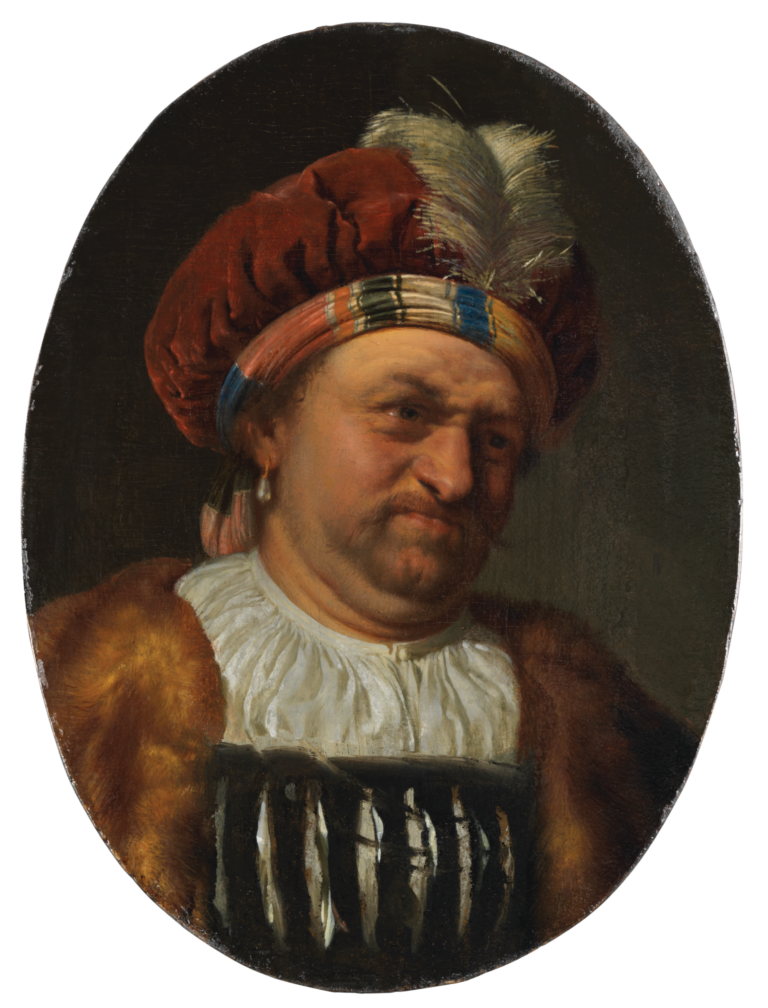In “Self-Portrait” in Fanciful Dress, Frans van Mieris indulged himself to the fullest with colorful, imaginary clothing elements, particularly his red velvet beret with white ostrich feather and the multicolored scarf knotted behind his head that holds the feather in place. A loosely pleated white linen shirt and a black jerkin with slashed openings are visible beneath the fur-trimmed robe around his shoulders. The pearl earring dangling from his ear reinforces the exotic nature of this wardrobe, which was unlike attire worn in the Dutch Republic. The same distinctive combination of headgear—red velvet beret, colored scarf, and feather—appears in Van Mieris’s Man in Oriental Dress, 1665, in the Mauritshuis, where the figure, appropriately, stands next to a column before a foreign, mountainous landscape (fig 1).1
As is characteristic for this Leiden fijnschilder (“fine painter”), Van Mieris applied the paint thinly and smoothly in this small oval panel painting while, at the same time, varying his strokes to model the face, fur, and jerkin. Judging from the extremely fine elaboration of the details, Van Mieris intended this small treasure to be seen closely, and without doubt, art lovers would have held this painting in their hands to admire its outstanding technique. They would have equally admired the lively, scrunched-up expression of the middle-aged, mustached subject, who looks as though he is reacting to something slightly unappealing.
Whether Van Mieris’s main interest was to express a certain emotion or to show a figure in fanciful dress, the sitter’s features clearly resemble those of the artist himself. However, this small painting, despite its title, is not a self-portrait, but rather an expressive character study known as a tronie. “Self-Portrait” in Fanciful Dress is closely related to another Van Mieris tronie in The Leiden Collection, “Self-Portrait” with a Plumed Beret (fig 2), where the artist, wearing a similar red velvet beret and colored scarf, expresses surprise.2 Van Mieris learned the art of making tronies in Leiden from his teacher, Gerrit Dou (1613–75), as well as from Rembrandt van Rijn (1606–69), who did more than any other artist to popularize tronies in his paintings and prints (fig 3).3 For modern-day viewers, the distinction between tronies and self-portraits can be difficult to discern, but seventeenth-century inventories often make a clear division.4 One has to remember that the word self-portrait only came into use in the nineteenth century; if one wished to speak of a Rembrandt self-portrait, one described it as “Rembrandt’s likeness done by himself” or “the portrait of Rembrandt painted by himself.”5
That this painting was recognized as a tronie can be deduced from the inventories of its early owners, among them Jan van Beuningen (1667–1720), a man of standing in the art world and a banker and merchant in the Baltic, and Pieter de la Court van der Voort (1664–1739), an extremely wealthy cloth merchant and a famous collector who had a penchant for works by the Leiden fijnschilders.6 De la Court van der Voort assembled a large body of works by Dou and Van Mieris in his house on Rapenburg 26 in Leiden.7 In a 1731 inventory of his collection, the little painting by Van Mieris is mentioned for the first time as “Een Persiaantje met een tulbant” (A little Persian with a turban).8 After Allard de la Court van der Voort (1677–1755) inherited the panel from his father, it was listed in his 1749 inventory as “An oval being a Persian or Turkish figure with a Turban on the head.”9 In 1766, the painting was sold at public auction from the collection of his widow, Catharina Backer (1689–1766), again as “A Persian.”10
Van Mieris’s painting was soon acquired by the famous Leipzig banker Gottfried Winckler (1731–95), who included it in the extensive catalogue of his collection published in 1768.11 Johann Friedrich Bause (1738–1814) made an engraving after Van Mieris’s painting when it was in Leipzig, giving it the title Der Persianer (The Persian). Jean-François-André Duval (1776–1854) from Saint Petersburg subsequently acquired Van Mieris’s painting from one of Winckler’s heirs.12 When it was in his collection, Ignaz Sebastian Klauber (1753–1817), or one of his studio assistants, made a reproductive engraving after the painting from a drawing by Pavel Nikolaivich Michailoff (1786–1840) (fig 4). Although Klauber’s engraving appeared in the 1846 catalogue of Duval’s collection, by that time Duval had already sold the collection to Napoleon III’s half-brother, Charles-August-Louis-Joseph (1811–65), Duc de Morny, who lived in Paris, but who dispersed many of his newly acquired paintings in London.13
Van Mieris’s painting seems to have remained in England until 1903, when the German-Jewish banker Max Steinthal (1850–1940), famous for financing Berlin’s metropolitan railway, acquired it. Wilhelm von Bode (1845–1929), director of the Berlin museums, advised Steinthal and his wife and probably recommended the purchase of this panel.14 In 1935, the Nazis forced Max Steinthal to resign from the Deutsche Bank, and the collection that he and his wife had formed was confiscated—a fate this painting escaped. The couple’s daughter, Eva Steinthal, had always kept this small panel; she sold it at auction in 2012.15 Prior to that time, its appearance was only known through the two early nineteenth-century engravings.16 Although recent examinations have found no trace of a signature or date on the panel, old sources indicate that it once bore a date of 1667, which is entirely consistent with the artist’s style at that period of his career.17 Two early copies of Van Mieris’s tronie—one can be tentatively attributed to Willem van Mieris (1662–1747), the artist’s son (fig 5)—indicate that this painting had a certain renown during and after his lifetime.18 After The Leiden Collection acquired this wonderful little gem in 2017, it found a home among many paintings by Van Mieris and other Leiden fine painters.
